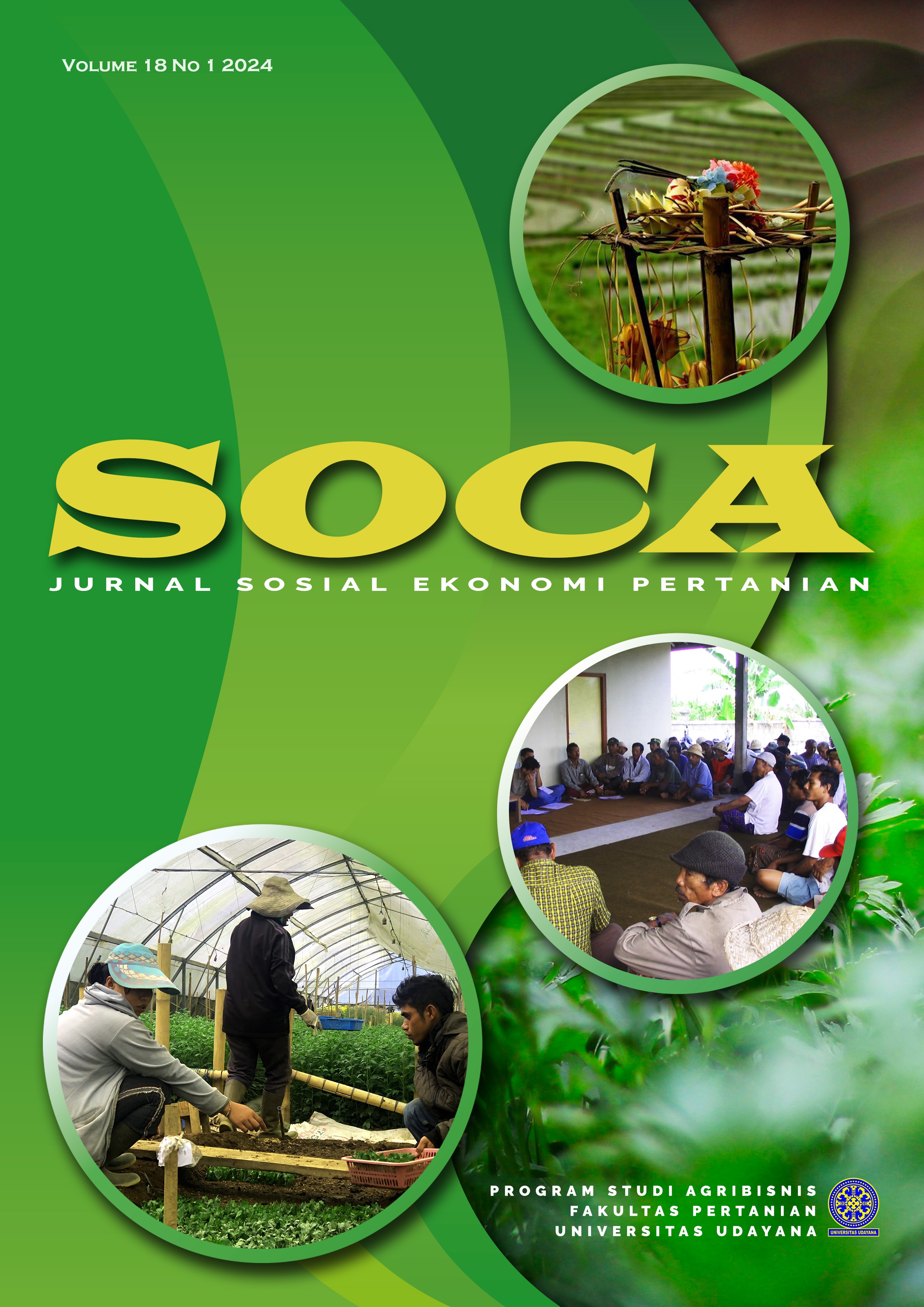Competitive Power of Gondorukem Indonesia in International Market
Abstract
Indonesia is the first number exporting country of gondorukem in 2022 in the world. However, the government and community have not paid much attention to the development of gondorukem thereby affecting the optimum production. This research is intended to analyzing the competitive power and the determining factors of competitive power for gondorukem Indonesia in the framework of Porter’s Diamond Model. Data analysis in this research was made using the ISP analysis media and approach of Porter’s Diamond Model. Based on average score of ISP gondorukem Indonesia of 2013-2022, The position of maturation has most firm competitive power. Based on the analysis with Porter’s Diamond Model, we know that the competitive power of gondorukem Indonesia is affected by the condition factor, demand condition, supporting industry, and competition; structure; and strategy. Condition factor is indicated by the extensive pine land, many and cheap workers, sufficient capital, growth in knowledge, and sufficient infrastructure. Demand condition is indicated by the qualified domestic market demand. Supporting industry is indicated by the lot demand of gondorukem in the paint, ink, and batik industries. Competition, structure, and strategy are indicated by the control of production materials and market by BUMN Perum Perhutani, so it eases the development of gondorukem qualitatively and quantitatively. Information found related to the competitive superiority can be served as the reference of developing the domestic gondorukem.
Downloads
References
Agil., Fauzi, M. R. A., Prakoso, P. J., & Luthfianto, S. (2022). Analisis metode hazop untuk mengurangi sumber bahaya pada proses produksi gondorukem di PPCI Pemalang. J. Sains dan Teknologi, 12(1), 154–159. http://dx.doi.org/10.36499/psnst.v12i1.
Andini, D., Edy, Y., & Dahlan, F. (2016). Peningkatan daya saing ekspor produk olahan kakao Indonesia di pasar internasional (studi pada ekspor produk olahan kakao Indonesia tahun 2009-2014). J. Administrasi Bisnis, 38(2), 171–175. http://administrasibisnis.studentjournal.ub.ac.id/index.php/jab/article/view/1523.
Arikunto, S. (2014). Prosedur Penelitian Suatu Pendekatan Praktek. Rineka Cipta: Jakarta.
Arisena, G. M. K., & Oktavia, H. F. (2020). Agricultural Commodity Supply Response. SOCA: Jurnal Sosial Ekonomi Pertanian, 14(2), 362–380. https://doi.org/10.24843/SOCA.2020.v14.i02.p15.
BPS (2023). Total People in the Mid-Year (Thousand of Lives) 2021-2023. Central Bureau of Statistics: Jakarta.
BPS (2023). 2023 Population and Worker Mobility Statistics. Central Bureau of Statistics: Jakarta
Cunningham. (2007). Historical and social factors affecting pine management in the Ozarks during the late 1800s through 1940. In: Kabrick JM, Dey DC, Gwaze D (eds) Shortleaf pine restoration and ecology in the Ozarks: proceedings of a symposium. US Department of Agriculture, Forest Service, Northern Research Station Newtown Square, 1–7.
Fahrodji, A., Sumarwan, U., Suhendang, E., & Harianto. (2009). Perbandingan daya saing produk gondorukem di pasar internasional. J. Manajemen & Agribisnis, 6(2), 140–151. https://www.researchgate.net/deref/https%3A%2F%2Fcreativecommons.org%2Flicenses%2Fby%2F4.0%2F?_tp=eyJjb250ZXh0Ijp7ImZpcnN0UGFnZSI6InB1YmxpY2F0aW9uIiwicGFnZSI6InB1YmxpY2F0aW9uIiwicG9zaXRpb24iOiJwYWdlSGVhZGVyIn19.
Godinho, T. D. O., Moreira, D. A. F., Moreira, S. O., Caldeira, M. V. W. (2018). Ró-resina: programa de expansão do plantio de pinus para produção de goma resina e madeira no espírito santo. Blibioteca Journal, 2, 20–41. https://www.researchgate.net/publication/331990287_PRO-RESINA_PROGRAMA_DE_EXPANSAO_DO_PLANTIO_DE_PINUS_PARA_PRODUCAO_DE_GOMA-RESINA_E_MADEIRA_NO_ESPIRITO_SANTO.
Gunawan, S. (2023). Potensi dan Industri Pengolahan Getah Pinus di Indonesia. IPB Universty: Bogor.
Hanafi, B. T., & Yuliani, T. (2022). Pengembangan strategi PT. Inhutani IV (persero) Distrik Tanah datar dalam meningkatkan kesejahteraan masyarakat melalui usaha produksi getah pinus di Kecamatan Tanjung Emas menurut hukum Islam. J. Studi Keislaman, 7(1), 1–16. http://dx.doi.org/10.31958/jeh.v7i1.6028.
Handayani, T. (2015). Relevansi lulusan perguruan tinggi di Indonesia dengan kebutuhan tenaga kerja di era global. J. Kependudukan Indonesia, 10(1), 53–64. https://doi.org/10.14203/jki.v10i1.57.
Horst-Heinan, T. Z., Dalmolin, R. S. D., Caten, A. S., Moura-Bueno, J. M., Grunwald, S., Pedron F. D. A., Rodrigues, M. F., Rosin, N. A., & Silva-Sangoi, D. V. D. (2021). Soil depth prediction by digital soil mapping and its impact in pine forestry productivity in South Brazil. Fores Ecology and Management Journal, 488, 1–12. https://doi.org/10.1016/j.foreco.2021.118983.
Imanuddin, R., Hidayat, A., Rachmat, H. H., Turjaman, M., Nurfatriani, F., Indrajaya, Y., & Susilowati, A. (2020). Reforestation and sustainable management of Pinus merkusii forest plantation in Indonesia: A Review. Forests, 11(12), 12–35. https://doi.org/10.3390/f11121235.
Kementerian Perindustrian Republik Indonesia (2023). Data industri. Tersedia pada: https://kemenperin.go.id/direktori-perusahaan?what=cat&prov.
Khadafi, M., Rostika, I., & Hidayat, T. (2014). Pengolahan gondorukem menjadi bahan pendarihan sebagai aditif pada pembuatan kertas. J. Selulosa, 4(1), 17–24. http://dx.doi.org/10.25269/jsel.v4i01.53.
Kharismawati, D., Indrasti, N. S., & Suprihatin. (2016). Strategi implementasi produksi bersih untuk meningkatkan kinerja industri gondorukem (studi kasus Nagreg Jawa Barat). J. Aplikasi Manajemen, 14(4), 705–713. http://dx.doi.org/10.18202/jam23026332.14.4.11
Nursodik, H., Santoso, S. I., & Nurfadillah, S. (2021). Competitiveness of Indonesian Tea Export in Southeast Asia Markets. SOCA: J.Sosial Ekonomi Pertanian, 16(1), 1–14. https://doi.org/10.24843/SOCA.2022.v16.i01.p01.
Perhutani (2014). Perhutani operasikan pabrik gondorukem. Available at: https://www.perhutani.co.id/en/perhutani-operasikan-pabrik-gondorukem/.
Perhutani. (2016). Perhutani tingkatkan layanan bagi pembeli gondorukem. Available at: https://www.Perhutani.co.id/Perhutani-tingkatkan-layanan-bagi-pembeli-gondorukem/.
Perhutani. (2018). Laporan Tahunan Perum Perhutani 2018. Available at: https://drive.google.com/file/d/1O4eOgAB3Bxy6MCz_FKdE3PqGLK4WWZAi/view.
Perhutani. (2021). Laporan Tahunan Perum Perhutani 2021. Available at: https://drive.google.com/file/d/1XECYi4lh0DeamLAsTGo19X__IzLCl9e8/view.
Perhutani. (2022). Laporan Tahunan Perum Perhutani 2022. Available at: https://drive.google.com/file/d/1fe3jJyWiOHqAgaYfjuCDc99gWk20wK7m/view.
Perhutani. (2023). Perhutani Forestry Industry(PeFI). Available at: https://www.Perhutani.co.id/tentangkami/strukturorganisasi/divisregional/Perhutani-forestry-institute-pefi/.
Parmadi, Emilia., & Zulgani. (2018). Daya saing produk unggulan sektor pertanian Indonesia dalam pertumbuhannya dengan ekonomi. J. Paradigma Ekonomika, 13(2), 77–86. https://doi.org/10.22437/paradigma.v13i2.6677.
Porter, M. E. (1990). Competitive Advantage Of Nations. The Free Press New York.
Pudjiastuti, A. Q., Arisena, G. M. K., & Krisnandika, A. A. K. (2021). Rice Import Development in Indonesia. SOCA : J. Sosial Ekonomi Pertanian, 15(2), 390–405. https://doi.org/10.24843/SOCA.2021.v15.i02.p14.
Suranto, Y. (2018). Karakter dan kualitas godorukem kuna hasil penemuan di
Pemukiman Pecinan Kutoarjo Kabupaten Purworejo. J. Konservasi dan
Cagar Budaya Borobudur, 12(2), 47–60. https://doi.org/10.33374/jurnalkonservasicagarbudaya.v12i2.188.
Tanguy, C. (2016). Cooperation in the food industry: contributions and limitations of the open innovation model. Journal of Innovation Economics, 19(1), 61–86. http://dx.doi.org/10.3917/jie.019.0061.
Trademap. (2023). World exporter country of gondorukem year 2013-2022. Available at: https://www.trademap.org/Country.
Tupamahu, Y. M. (2015). Analisis daya saing ekspor cengkeh Indonesia di kawasan ASEAN dan dunia. J. Ilmiah Agribisnis dan Perikanan, 8(1), 28–35. http://dx.doi.org/10.29239/j.agrikan.8.1.27-35.
UN Contrade. (2023). Export value of gondorukem Indonesia to the world. Available at: https://comtradeplus.un.org/TradeFlow.
Yuniati, N. (2018). Analisis daya saing ekowisata dengan pendekatan porter’s diamond model kasus di Yogyakarta. J. Kepariwisataan, 12(3), 1–20. http://dx.doi.org/10.47256/kji.v12i3.78.













